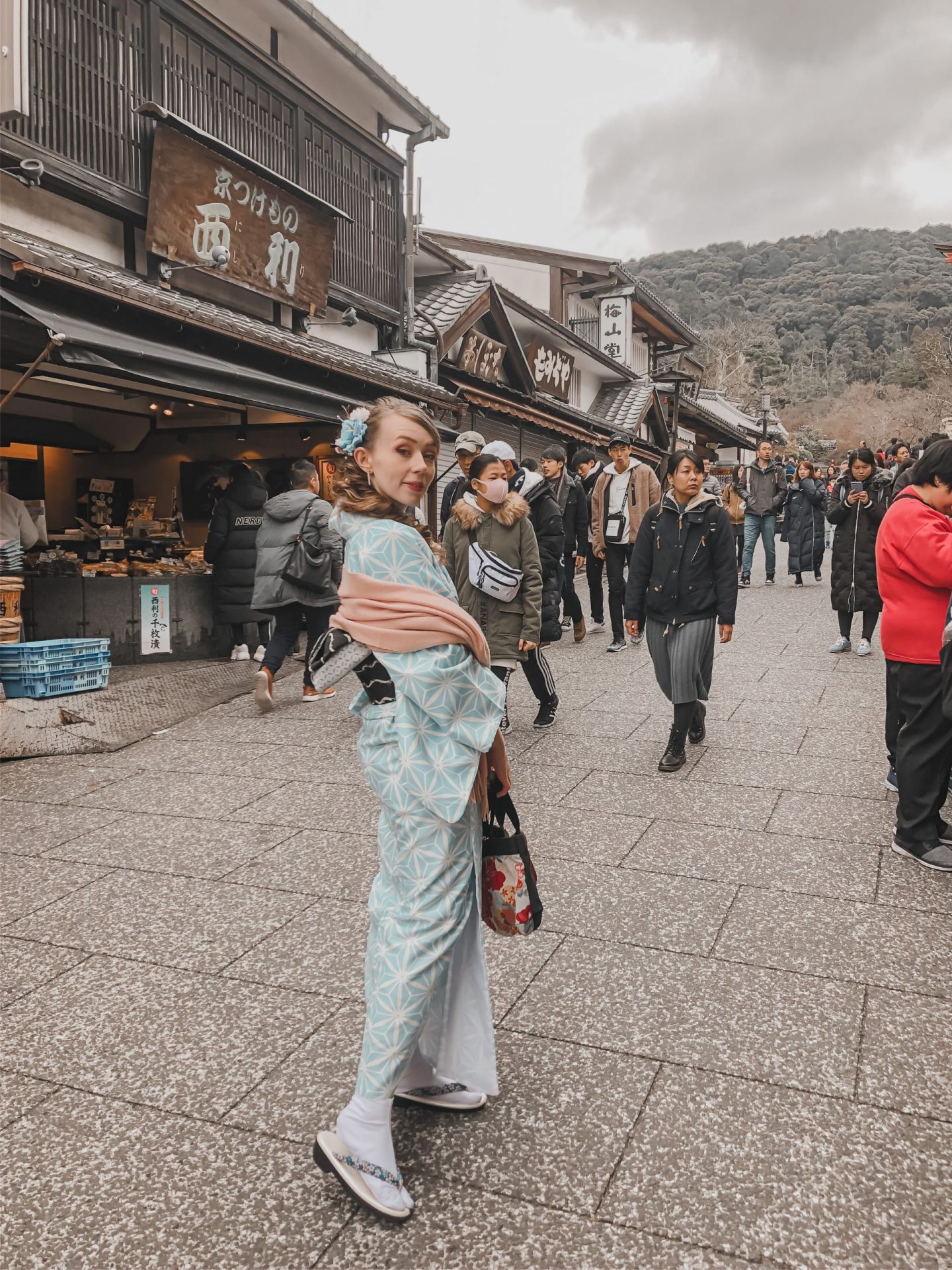


It has been a dream of mine for a very long time to wear Kimono. Coming from a country (England) that doesn’t really have a specific traditional outfit, it’s nice to experience the traditional clothes of another culture – as long as it’s in a respectful manner. I was so excited when talking through the details of my winter trip to Kansai with Izzy that she booked an appointment at a Kimono rental shop for our 2nd day in Kyoto. Cue very happy squealing. I was going to get my very first Kimono experience in possibly the best city for it.
Choosing our Kimono
We rented our Kimono from a company called Rental Kimono Okamoto. We went to their Kiyomizu-dera loctation, near Kiyomizu Temple, which has a really pretty garden where they can take photos for you, and is hidden down an alleyway so it’s not quite ‘on the main street’ of Kiyomizu-dori. They have 5 other locations: the Main shop, the Yasakano-to-mae shop, the Gion shop, the Yasaka Jinja shop, and the Kiyomizu Higashiyama shop – so depending on how you want to plan your Kimono wearing experience will depend on which store you’d want to choose.
Booking the appointment wasn’t something that I did (eternally thankful to Izzy <3) but the process seems to be very simple on their website. You pick a location, the number of people who will be fitted, the date, a time slot, and then finally the type of plan you wish to go with. Plans include getting everything chosen for you (the way I went – it’s overwhelming to match things sometimes), to very high class Kimono experiences. You can add the option of getting your hair done (women only), and how you’ll return the Kimono. Payment happens at the location, before you are helped into your chosen dress and start your Kimono experience.
We decided that, since I’m pretty much standard size in Asia, that getting a set would be the easiest thing to do. That way, I would’t get stressed out with trying to match colours and patterns together. Izzy, since she’s taller, decided to choose everything so that we could twin a little bit. We both went for blue, and the lady assigned to make the process go smoothly was incredibly helpful.
Having the Kimono put on was really easy, even though I don’t speak Japanese (anymore, I did learn for a time whilst I was in university) past the absolute bare minimum. The lady who helped me into mine was magic, thoroughly efficient and left me reeling at how intricate the process was. There are a lot more ties than I thought there would be, but it didn’t take too long at all, and for the most part I just felt like a doll as she did everything that needed to happen to make the kimono sit just right.
Next, it was on to hair. To get your hair styled, it’s an additional 500Yen (you can see the pricing on the website) and happens either once you’re fully fastened into your Kimono, or in the middle once you’re in the under layer of the Kimono, or nagajuban. You can choose from 6 designs of varying complexity, and once the style is finished you can add as many hair accessories as you like. For a lot of the styles, having one accessory that hangs down looks super cute, I’d definitely recommend adding one if you’re not sure on which pieces to choose.

[aff] See more Kimono Rental options
Wearing Kimono
I was genuinely surprised at how comfortable wearing Kimono was, considering how much effort it took to fasten. Walking took a little getting used to as your legs are slightly more restricted than normal, so things like stairs were a challenge at first. I got the hang of it fairly quickly, which was use useful considering we were walking around Kiyomizu Temple and there are a fair amount of stairs. I was also surprised that I didn’t feel particularly cold in just the Kimono. I didn’t bring heat-tech with me to Japan for the time I was there on holiday, so I was fairly worried that I was going to freeze… but we were fortunate with the weather and, even though we didn’t last a whole day, it wasn’t uncomfortable.
Walking around the older areas of Kyoto and visiting Gion whilst dressed in Kimono was also really interesting, especially seeing people’s reactions. Although seeing foreigners dressed in Kimono isn’t by any means a rare occurrence, I always find it amusing to see how people react to it. Izzy had warned me that we might get people asking to take pictures, or even trying to take them without our knowledge – and I did notice it now and again, but it isn’t really anything I haven’t experienced before. Similar things happen in Korea when I wear Hanbok to visit the palaces.
Honestly, it was a really enjoyable Kimono experience, and I’d love to wear one again.

Any tips for an easier Kimono experience?
Having the ‘set’ option where everything was already paired together really helped me not feel overwhelmed by the colours, patterns, and fabrics available. Next time I think I’ll choose my own, but I’ll definitely be asking the staff for help with matching Obi’s to Kimono.
Definitely wear clothes that are easy to get in and out of, and appropriate layers for the weather. I wore jeans and a sweater, so I wasn’t messing around with lots of my own clothes to put inside the bags they give to keep all of one customers items together.
Be prepared to have great posture for the whole time you are wearing Kimono. The obi (sash) is really thick, and tied to keep everything from moving around so it acts like a sort of fabric back brace. If you’re prone to slouching (me) then you might be in for a shock. But! It’s easier to walk in Kimono if you have good posture.
Go early to maximise the amount of time you have for the Kimono Experience. I’d really like to try wearing one for a whole day – not just a couple of hours – next time, so going early will really help with that.
Pin me for later

Have you ever worn Kimono before? I’d love to try out a brighter or bolder pattern next time I do – there will be a next time. What would you pick? Let me know in the comments, and don’t forget to hop onto my Instagram to see more photos from my trip to the Kansai region of Japan.







Leave a Comment